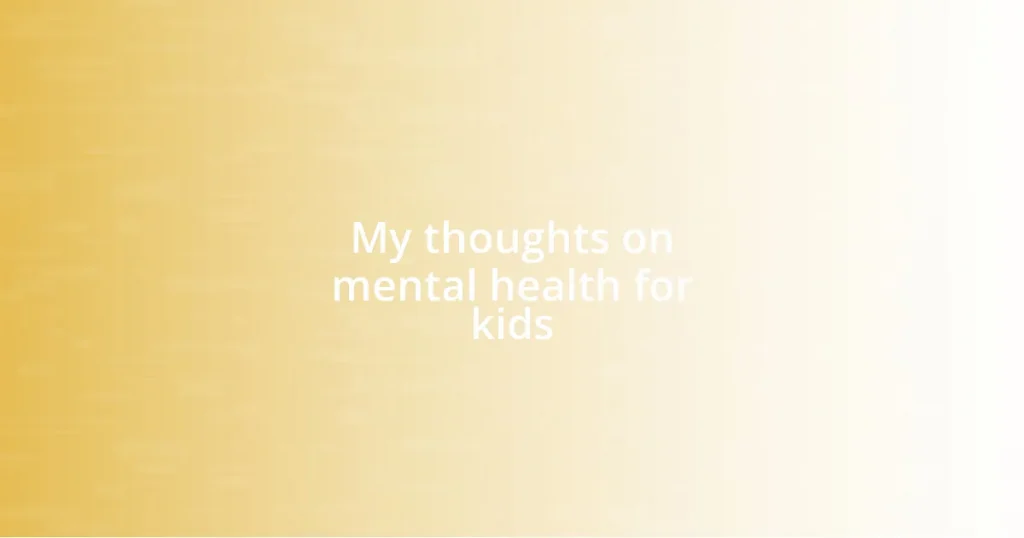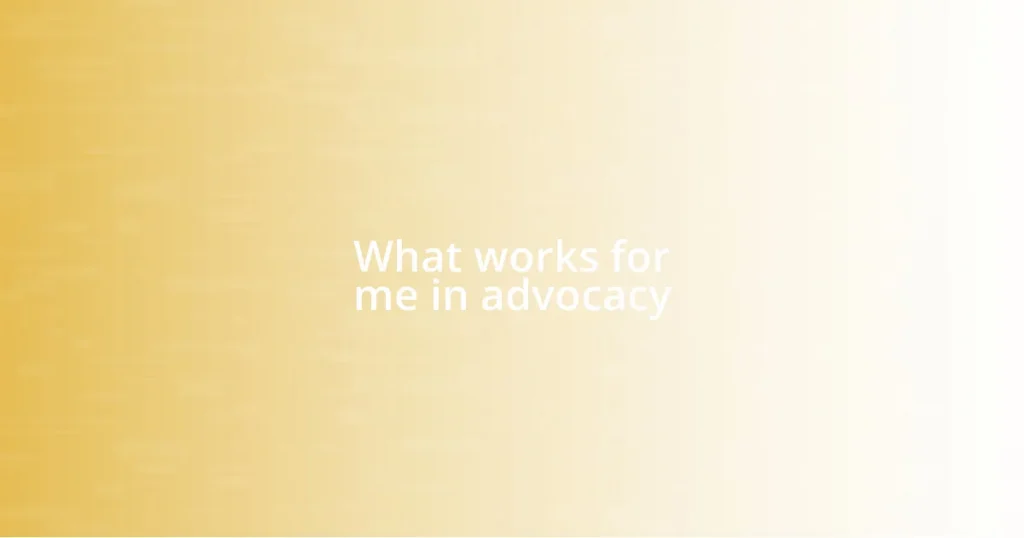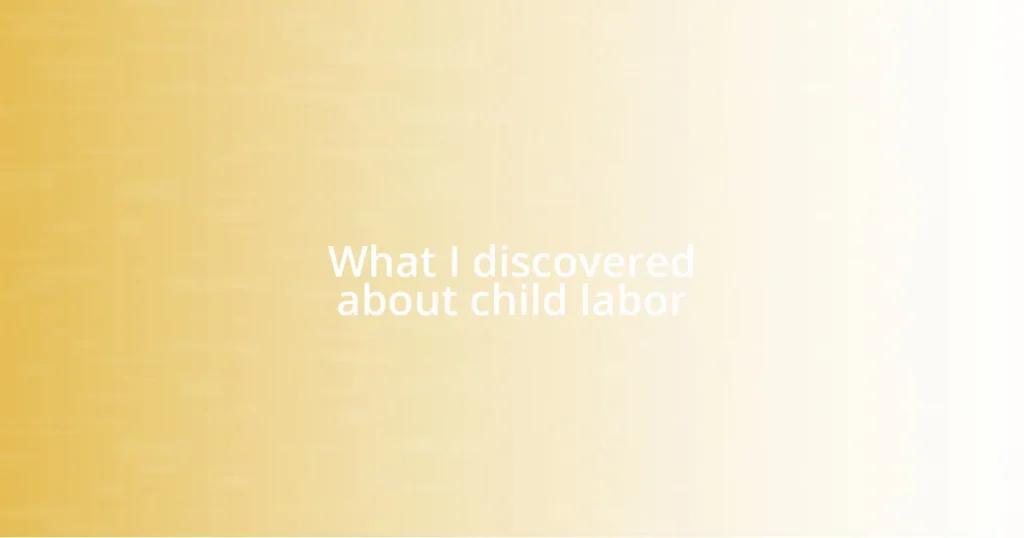Key takeaways:
- Early recognition and intervention in children’s mental health can prevent long-term negative effects and foster better outcomes.
- Effective communication, including active listening and using age-appropriate language, is essential for understanding and supporting kids.
- Encouraging healthy coping mechanisms such as physical activity and gratitude can help children manage their emotions and anxieties.
- Accessing resources like support groups and educational materials can provide valuable help and open dialogues about mental health issues.

Understanding mental health for kids
Understanding mental health for kids is essential, yet often overlooked. I remember when my young niece was feeling anxious about starting school, and it hit me how crucial it is to recognize those feelings as part of a broader mental health landscape. Have you ever noticed how easily children internalize stress? It’s so important to create an environment where they can express these emotions.
Kids may not always articulate their feelings, but their behavior often tells a story. I’ve seen children withdraw when they’re overwhelmed, which makes me wonder how many adults miss the signs of struggling youth. When I reflect on my childhood, I see moments where I wished someone would’ve understood what I was going through; simple conversations could have made such a difference.
What many don’t realize is that mental health for kids can fluctuate just like physical health. For instance, during my son’s early school years, he encountered a couple of friends dealing with family issues. Witnessing their struggle opened my eyes to how interconnected kids are with their peers’ emotional well-being. This connection emphasizes the importance of fostering empathy and understanding in our younger generation.

Importance of early mental health
The early stages of a child’s development are critical for mental health. I recall a time when my daughter faced challenges with self-esteem after a disappointing school project. It reminded me how early negative experiences can shape a child’s mental outlook. Addressing these issues early on can prevent negative patterns that follow children into adulthood.
It’s fascinating to think about how mental health in kids isn’t just about individual struggles; it influences their overall development. One summer, I volunteered at a local camp where kids were encouraged to express their feelings through art. The transformation I witnessed was incredible. Children who once seemed withdrawn began to open up, and it highlighted the need for supportive environments where mental health can be nurtured from a young age.
Moreover, research shows that early intervention can lead to better outcomes in mental health. I’ve spoken with educators who pointed out how addressing mental health concerns, like anxiety or stress, improves classroom dynamics. Children who feel secure and accepted are more likely to engage, learn, and thrive. It’s a powerful reminder of the role we play in shaping their early experiences, which can have a profound impact on their lifelong mental wellness.
| Aspect | Importance |
|---|---|
| Early Recognition | Identifying issues early can help mitigate long-term effects. |
| Supportive Environments | Nurturing spaces foster openness and self-expression. |
| Peer Influence | Children’s mental health is interconnected with their peers. |
| Long-term Benefits | Early intervention leads to better mental health outcomes. |

Signs of mental health issues
Recognizing signs of mental health issues in children can often be challenging, but there are telltale indicators to watch for. I remember a friend’s daughter who transformed from a bubbly, talkative child into someone who barely spoke about her day. Observing that shift opened my eyes to the subtle signs of distress that can manifest in silence. Often, kids struggle to express themselves verbally, leaving their feelings to emerge in other ways.
Here are some signs to keep an eye on:
- Changes in Behavior: A sudden withdrawal from friends or activities they once enjoyed can be a red flag.
- Emotional Outbursts: Frequent tantrums or excessive irritability may indicate underlying anxiety or frustration.
- Changes in Sleep Patterns: Trouble sleeping or frequent nightmares can signal stress.
- Physical Complaints: Unexplained headaches or stomachaches might be manifestations of emotional turmoil.
- Decline in Academic Performance: A drop in grades or lack of interest in schoolwork can point to deeper issues.
It’s fascinating how easily children can transition from happy to withdrawn. I recall volunteering in a classroom where one little boy, who used to gleefully share his stories, began to sit apart from others. It was heartbreaking to watch. Eventually, through consistent conversations and gentle encouragement from his teacher, he slowly opened up about feeling lonely. It reminded me that, even in subtle ways, children share their struggles—they just need a safe space and someone to listen.

Tools for supporting kids
Supporting kids’ mental health takes more than just awareness; it requires the right tools and strategies. One tool I’ve found particularly effective is the use of mindfulness exercises. When I introduced breathing techniques to my own children during moments of stress, I was amazed at how quickly they adapted. Have you ever tried guiding a child through deep breathing? Watching them relax in real time is one of the most rewarding experiences I’ve had as a parent.
Another useful tool is open communication. I remember a heart-to-heart talk with my son about what it feels like to face disappointment. By encouraging him to express his feelings honestly, I noticed a significant reduction in his anxiety. It made me realize that simply providing a non-judgmental space for kids to share their thoughts can be transformational. Have you experienced a similar breakthrough in your conversations?
Creative outlets, such as drawing or writing, also play a vital role in supporting young minds. I’ve seen how drawing became a language for my daughter during tough times. One night, she sat at the kitchen table, sketching her worries instead of making them words. This not only helped her articulate her emotions but gave her a sense of control over them. Isn’t it powerful how creativity can provide a voice where words sometimes falter?

Strategies for effective communication
Effective communication is key when supporting children’s mental health. I’ve found that active listening can make a significant difference. Once, while chatting with my daughter, I noticed how her eyes lit up when I mirrored her feelings back to her. It’s like she felt validated in her experience. Have you ever experienced the shift that occurs when a child feels truly heard?
Another strategy is to use age-appropriate language. I remember struggling to explain what anxiety was to my 8-year-old son. After some thought, I used the analogy of a storm cloud that sometimes hovers over him. His face lit up with understanding, and asking him about his “stormy days” became our way to check in. Simplifying complex feelings into relatable terms fosters connection and clarity.
Finally, patience plays a crucial role in communication. I’ve had moments when my youngest took what felt like ages to express her thoughts. Instead of rushing her, I learned to sit in the silence alongside her. In those quiet moments, I realized that she was often processing her feelings before sharing. Wouldn’t it be wonderful if we could all embrace that kind of patience in chatting with kids?

Encouraging healthy coping mechanisms
One healthy coping mechanism I’ve encouraged is physical activity. I remember organizing family walks during challenging times, and it was amazing to see how moving together lightened the mood. Have you ever noticed how even a short burst of play can shift a child’s perspective? It’s like unlocking a door to joy and connection.
I also believe in the power of routine. When my children were feeling overwhelmed, we established a simple evening routine that included a calming activity, like reading together. Creating that predictability helped them know what to expect, and I could see their anxieties ease as we bonded over those quiet moments. Isn’t it comforting how a little structure can provide a sense of security?
Additionally, I’ve found that teaching my kids to express gratitude has been transformative. During dinner, we started sharing what we were thankful for that day, and it turned into a beautiful ritual. I noticed how reflecting on positive experiences shifted their focus from worries to appreciation. Have you ever thought about how acknowledging the good can reshape a child’s emotional landscape?

Resources for further help
When seeking further help for children’s mental health, resources like local support groups or school counselors can be invaluable. I remember attending a parents’ workshop at my son’s school. It was reassuring to connect with other parents facing similar challenges. Have you ever felt that relief in knowing you’re not alone in your journey?
Online platforms also offer countless resources, including websites dedicated to mental health. I once stumbled upon a fantastic video series specifically designed for kids, teaching them about emotions through fun animations. That turned into a bonding activity for my family; we would watch together and discuss how each character was feeling. It’s incredible how these tools can open up dialogues about tough subjects, wouldn’t you agree?
Books can be a powerful way to further explore this topic. One evening, we picked up a storybook centered around a character dealing with feelings of sadness. As we read through it, I could see my daughter reflecting on her own experiences. It was like a gentle invitation for her to share her feelings, creating a safe space for deeper conversations. Have you noticed how the right story can resonate with a child’s heart and spark meaningful dialogue?















